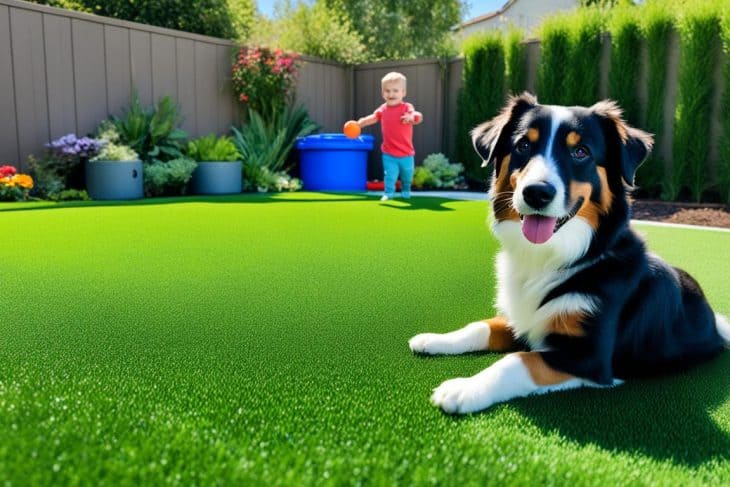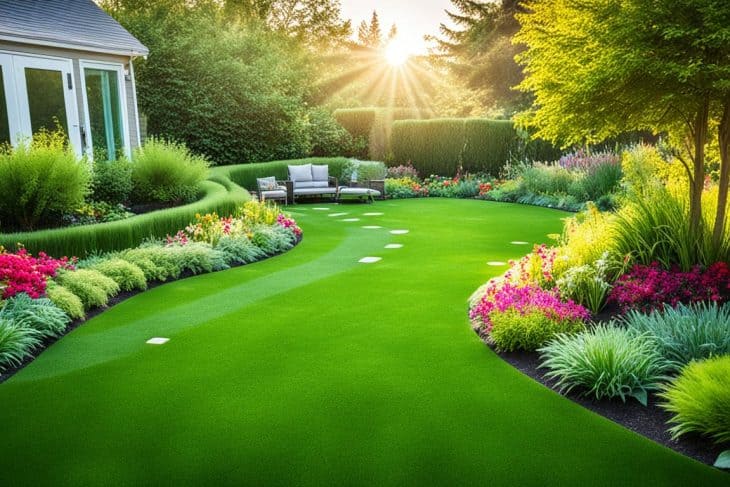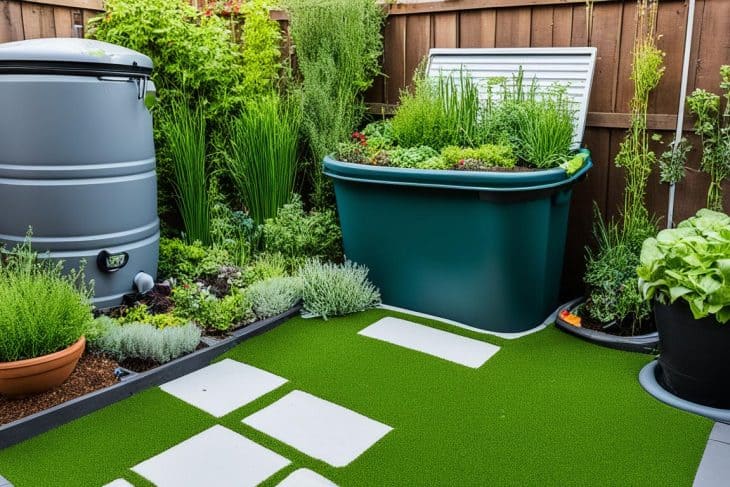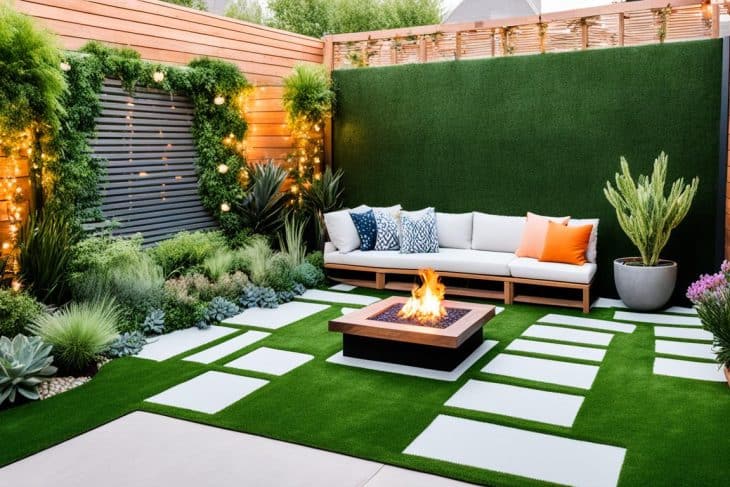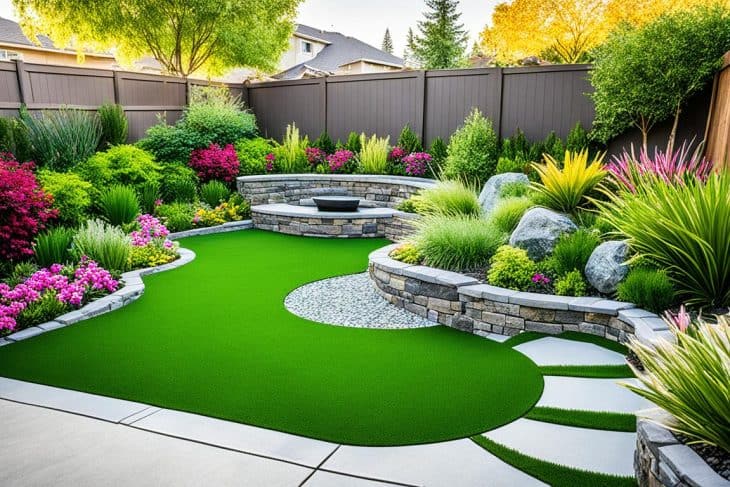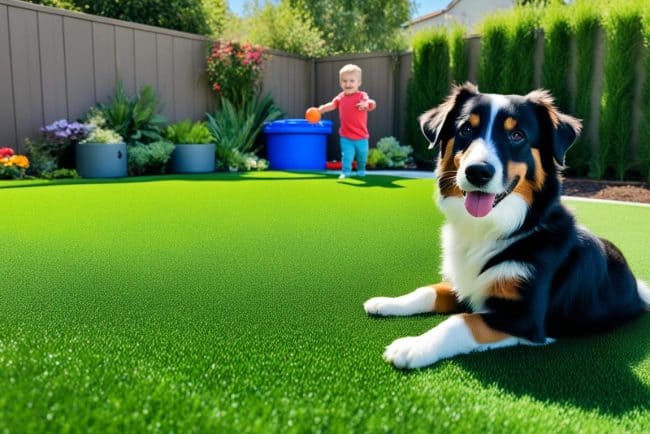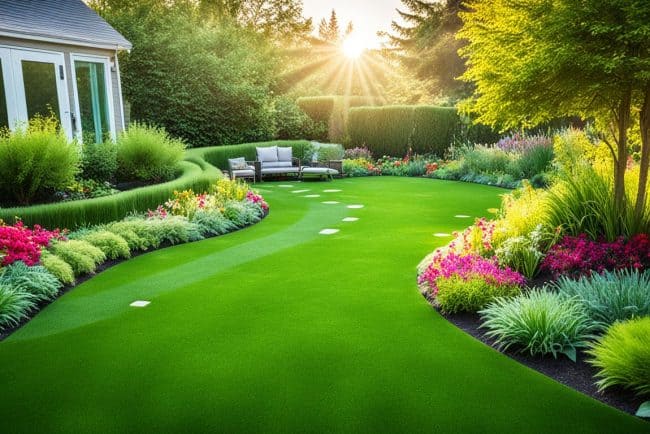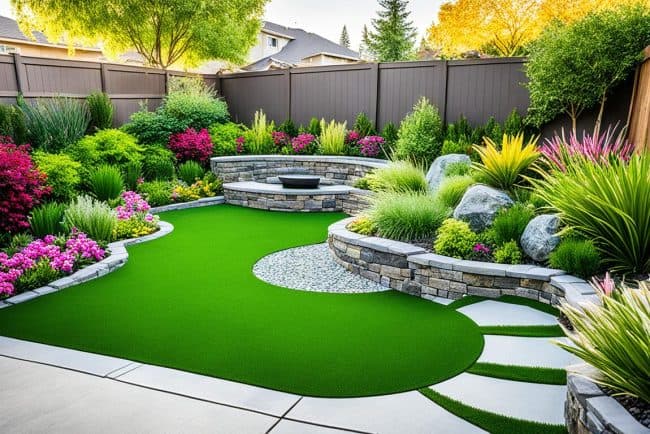When I first got artificial grass for my backyard, I thought it was a dream come true. No more heavy mower, no more weekly watering, and no more weeds. The first summer was a breeze, watching my loved ones enjoy the yard without lawn care stress. Easy lawn care became my reality.
But, as time passed, I learned that artificial grass still needs some care to stay looking great. It’s simpler than natural grass, but it’s not maintenance-free. Finding the right balance is key to keeping your lawn healthy and enjoying synthetic turf’s benefits. Let’s explore some easy maintenance tips to keep your artificial grass looking beautiful for years.

Key Takeaways
- Artificial grass can last between 15 to 25 years with proper maintenance.
- Regular cleaning including debris removal and rinsing is essential for turf upkeep.
- Easier to maintain than natural grass, yet some care is still required.
- Immediate cleanup of spills and pet waste helps maintain a clean and presentable lawn.
- Specific tools like leaf blowers and garden hoses are vital for effective care.
The Benefits of Artificial Grass for Homeowners
Homeowners looking for lawn alternatives find artificial grass has many advantages. It saves money and needs less upkeep. This makes it a great choice for many families wanting a nice yard.
Cost-Effective Lawn Solutions
Artificial grass is a smart investment that saves money over time. The cost to install it ranges from $6.00 to $20.00 per square foot. But, it cuts down on water use and lawn care costs, offering big savings.
By skipping lawn sprinklers and mowers, I save a lot of money. Artificial lawns can reduce water bills by up to 70%. Since half of home water use is wasted, these savings are even more valuable.
Reduction in Maintenance Time
Artificial grass also gives me more free time. Americans spend about 70 hours a year mowing. With this turf, I don’t lose those hours. Now, I can spend my time with family or on hobbies, and my lawn stays nice.
Environmental Impact & Water Conservation
Artificial grass is good for the environment. In places like South Florida, it saves about 55,000 gallons of water per year for a 1,000-square-foot lawn. This is a smart choice, especially since Americans use 9 billion gallons of water daily for lawns. Choosing artificial grass helps my home and the planet.
| Feature | Artificial Grass | Natural Grass |
|---|---|---|
| Installation Cost | $6.00 – $20.00 per sq ft | Varies by region |
| Water Usage | Significantly reduced | 9 billion gallons daily in the US |
| Maintenance Time | Minimal time investment | 70 hours/year average mowing time |
| Life Expectancy | 20-25 years | Varies, often shorter |
| Environmental Impact | Supports water conservation | Can lead to overuse of resources |
Easy Lawn Care: Simple Maintenance Tips for Your Artificial Grass
Keeping your artificial grass looking great takes effort and a plan. Regular cleaning and following key maintenance tips help homeowners keep their lawns perfect. It’s key to know how to clean and remove debris to make your turf last longer.
Regular Cleaning Techniques
Cleaning your artificial grass often is crucial. I suggest washing your turf with a garden hose weekly. This keeps dust, dirt, and other bits away. For leaves or heavy debris, a good brush helps a lot. TigerTurf recommends a stiff-bristled broom to keep the grass upright.
For tough stains like motor oil or crayons, use mineral spirits. It safely removes the stain without harming your lawn.
How to Remove Debris Effectively
Removing debris from synthetic turf needs a plan. Start by checking your lawn for leaves, pet waste, or dirt. Pet owners should pay extra attention to keep smells and bacteria away.
I use a fine rake to pick up leaves and debris, making sure they don’t stick in the grass. A maintenance schedule with daily, weekly, and monthly tasks keeps my lawn looking good, safe, and inviting.

Understanding Synthetic Turf Upkeep
Looking after synthetic turf means knowing how long it lasts and what pet-friendly artificial turf needs. With the right care, your synthetic turf can last 15 to 25 years. Keeping up with maintenance makes sure your lawn stays clean and useful.
Long-Term Durability and Lifespan
For a long-lasting artificial grass, cleaning it often is key. Brushing it regularly keeps the grass fibers standing tall and spreads the sand evenly. In places with lots of rain, like Seattle, it’s important to clean off debris to avoid problems. Using weed control and treatments during the seasons keeps your turf healthy for a long time.
Dealing with Pet Waste on Artificial Grass
Pet owners need a clean space. Pet-friendly turf with antimicrobial material cuts down on smells and keeps pets safe. Cleaning up pet messes quickly stops stains and smells. A mix of water and mild soap with a sponge gets rid of stains well. Washing the turf with a hose takes away any leftover pet waste, keeping it clean.

In busy areas, replacing worn-out parts of the turf is a good idea to keep your lawn looking good. Tools like blowers, brooms, and power washers are key for upkeep, especially in tough weather. With careful maintenance, your synthetic turf looks great and lasts longer, making a wonderful outdoor space for everyone.
| Maintenance Task | Recommended Frequency | Purpose |
|---|---|---|
| Regular Brushing | Weekly | Maintain fiber upright position |
| Debris Removal | As needed | Prevent mold and bacteria buildup |
| Hosing Down | Weekly | Remove pet waste and odors |
| Weed Treatment | Twice a year | Prevent weed growth |
| Spot Cleaning | As needed | Remove stains |
Adapting to South Florida’s Unique Climate
Living in South Florida brings special challenges for keeping a lawn looking great. The intense humidity and heat can be tough. But, picking the right artificial grass can really help. Look for products made for humid climates. They stand up to the weather and keep your lawn looking good all year.
Choosing the Right Turf for Humidity and Heat
For south Florida turf solutions, find synthetic grasses that do well in high humidity and heat. These grasses don’t fade or wear out easily, keeping your yard looking green and full of life. Also, choose textures and colors that look like real grass to make your yard look better and be practical for the weather.
Water Conservation Practices with Synthetic Grass
Using water conservation with synthetic turf is key to a green garden in South Florida. Lawns here need 1 to 1.5 inches of water a week. Synthetic grass means you don’t need to water it often. By using rainwater systems and mulch, you can save water and keep your lawn beautiful.

Creating a Family-Friendly Yard with Artificial Grass
Switching to artificial grass can make your outdoor area better, especially if you have kids and pets. It doesn’t need harmful chemicals like pesticides or fertilizers. So, my kids can play safely without worrying about toxic substances.
The soft surface of synthetic turf also makes it a safe place for kids to play. It lowers the chance of getting hurt during fun activities.
Safety Features for Children and Pets
Many artificial grass products come with cushioning that absorbs impacts. This makes them perfect for play areas. The turf is also tough and can handle lots of play, keeping it safe for my kids and pets.
It’s also easy to keep clean—no more muddy paw prints or grass stains. This keeps my home clean and welcoming.
Impact on Outdoor Activities and Play Areas
Artificial grass makes outdoor activities easy and fun without the need for upkeep. My yard is now a great place for family barbecues, sports, or just relaxing. I can even add waterplay areas without worrying about muddy spots.
This makes it ideal for a lively, family-friendly yard that everyone can enjoy all year.

